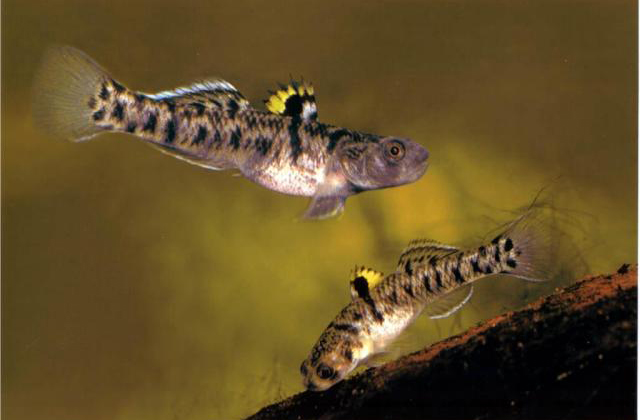Wilson's Mangrovegoby, Mugilogobius wilsoni Larson 2001
Other Names: Wilson's Goby, Wilson's Mangrove Goby

Wilson's Mangrovegoby, Mugilogobius wilsoni. Source: Neil Armstrong. License: All rights reserved
Summary:
A small light grey goby with a blunt snout, 5-7 dark oblique bands interspersed with black spots and chevron-like markings on sides, a large dark spot on first dorsal fin, and two dark spots on caudal-fin base.
Cite this page as:
Martin F. Gomon, Mugilogobius wilsoni in Fishes of Australia, accessed 01 Jul 2025, https://fishesofaustralia.net.au/home/species/2248
Wilson's Mangrovegoby, Mugilogobius wilsoni Larson 2001
More Info
|
Distribution |
Known only from northern Australia between the Joseph Bonaparte Gulf, WA and Mackay, QLD; a tropical benthic species, inhabiting small muddy bottomed mangrove creeks in brackish water or freshwater in tidal streams. |
|
Features |
Meristic features: Dorsal fin V-VI; I, 7-8; Anal fin I, 6-8; P 13-16; Caudal fin (segmented rays) 15-16, (branched rays) 13-16; Transverse scales 8-11; Gill rakers 3-7 + 7-10 = 10-17; Vertebrae 10 + 16. Body compressed, moderately slender, usually somewhat rounded anteriorly, depth 4.6-7.1 in SL. Head wider than deep, length 3.0-4.7 in SL; slightly depressed anteriorly and cheeks sometimes inflated in large males. Snout slightly rounded. Anterior nostril tubular, short, at edge of upper lip, directed down and forward, preorbital curved forward slightly to accommodate nostril; posterior nostril rounded to oval, close to centre of anterior margin of eye. Eyes lateral, high on head, top usually forming part of dorsal profile, 2.2-3.9 in head. Interorbital broad, flat to slightly concave; top of head from just behind eyes to snout tip usually covered with fine villi. Mouth subterminal, slightly oblique, reaching to below middle or posterior half of eye in males, to below anterior half of eye in females; upper jaw with outermost teeth largest, pointed and widely spaced; inner 2-4 rows with small curved sharp teeth, lower jaw with 3-4 rows of stout, sharp, inward curving teeth; teeth in females smaller and finer than in males.lips usually smooth; lower lip free at sides, broadly fused across front; tongue tip usually blunt, rarely concave; chin smooth. Gill opening usually extending forward to under opercle; inner edge of pectoral girdle smooth with no ridge or flange, with smooth bony flange, with low irregular fleshy ridge, or with distinct fleshy knobs or bumps, knobs rounded and fleshy or rather flattened flaps. Body fully scaled, ctenoid on side forward in wedge to behind pectoral fin; lateral line absent; longitudinal series 26-31; predorsal scales 11-13. Anteriormost predorsal scale enlarged, at rear of interorbital space, other scales on nape smaller, all cycloid. Upper third to half of operculum with small cycloid scales; cheek naked. Pectoral base and prepelvic area covered with cycloid scales. Belly with patch of ctenoid scales under pelvics, remainder cycloid. Head pores absent. Two dorsal fins; first somewhat rounded to triangular, not or barely reaching second dorsal origin when depressed; second dorsal and anal fins about equal in height to first dorsal, rays of males just reaching caudal base when depressed, distinctly not in females; anal rays not reaching caudal fin when depressed. Pectoral fin rounded, all but first branched. Pelvic fins fully united into disc, short, rounded to oval, reaching half to two-thirds of distance to anus. Caudal fin rounded. |
|
Size |
To around 4cm SL |
|
Colour |
Pale yellowish grey to grey, whitish below, with scale margins narrowly outlined in black giving overall reticulate background pattern; 6-7 black to dark grey oblique bars and spots on side, first bar angling forward behind pectoral base to above opercle, extending onto nape and sometimes meeting its counterpart on midline of nape, lower half of bars often sharply angled back posteriorly, forming chevrons; caudal fin-base scales with vertically oriented pair of black round to oval spots on pale background, giving ocellate appearance; upper half of pectoral base with rounded brown spot; side of head with two horizontal stripes, upper broader, from middle of upper lip below eye and breaking up on opercle as series of indistinct blotches or streaks, lower very narrow and wavy, from corner of mouth to near edge of preopercle. Outer third of first dorsal fin yellow above rounded black spot, outer edge of fin with very narrow brown margin; second dorsal fin and upper and lower edges of caudal fin with broad white margin; fins otherwise clear. |
|
Biology |
Oviparous, benthic spawners. Eggs hatch after 6-7 days at about 27°C. Larvae very small and free-swimming. |
|
Etymology |
The species is named for David Wilson, of the Northern Territory Wildlife Park, in recognition of his help in collecting gobies and promoting the appreciation of native Australian freshwater fishes. |
|
Species Citation |
Mugilogobius wilsoni Larson, 2001, Rec. West. Aust. Mus. Suppl. 62: 192, figs 167, 191–193. Type locality: drain at Leanyer Swamp, NT. |
|
Author |
Martin F. Gomon |
Wilson's Mangrovegoby, Mugilogobius wilsoni Larson 2001
References
Allen, G.R., Midgley, S.H. & Allen, M. 2002. Field Guide to the Freshwater Fishes of Australia. Perth : Western Australian Museum 394 pp.
Larson, H.K. 2001. A revision of the gobiid fish genus Mugilogobius (Teleostei: Gobioidei), and its systematic placement. Rec. West. Aust. Mus. Suppl. 62: 1–233.



